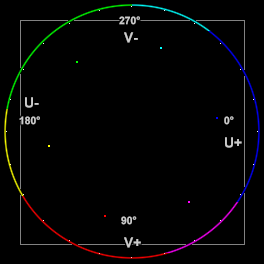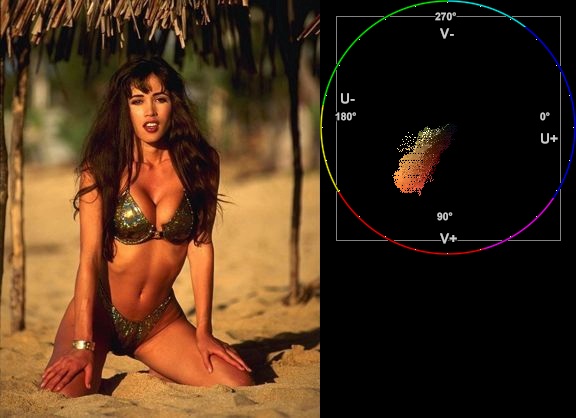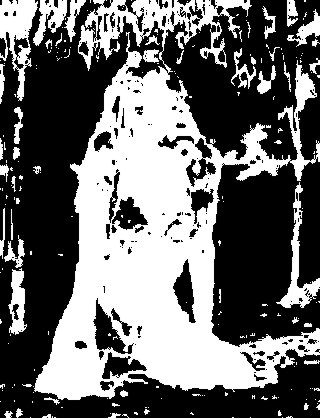MaskHS
From Avisynth wiki
(Difference between revisions)
(→Examples) |
Raffriff42 (Talk | contribs) (note AVS+ differences) |
||
| Line 1: | Line 1: | ||
| − | + | <div style="max-width:82em; min-width:42em;" > | |
| + | {{AvsStarFilter}}Returns a mask (as [[Y8]]) of clip using a given hue and saturation range. Added in v2.6. | ||
| + | |||
| + | {{AvsPluscon}} adds new [[#realcalc|{{FuncArg|realcalc}}]] parameter. | ||
| + | |||
| + | |||
== Syntax and Parameters == | == Syntax and Parameters == | ||
| Line 5: | Line 10: | ||
{{FuncDef | {{FuncDef | ||
|MaskHS(clip [, int ''startHue'', int ''endHue'', int ''maxSat'', int ''minSat'', bool ''coring'' ] ) | |MaskHS(clip [, int ''startHue'', int ''endHue'', int ''maxSat'', int ''minSat'', bool ''coring'' ] ) | ||
| + | }} | ||
| + | |||
| + | {{FuncDef | ||
| + | |MaskHS(clip [, int ''startHue'', int ''endHue'', int ''maxSat'', int ''minSat'', bool ''coring'', | ||
| + | bool ''realcalc'' ] ){{AvsPluscon}} | ||
}} | }} | ||
| Line 59: | Line 69: | ||
::Practically the saturation of a pixel will be in the range [0,100] (thus 0-100%), since these correspond to valid RGB pixels (100% corresponds to R=255, G=B=0, which has a saturation of 119). An overshoot (up to 150%) is allowed for non-valid RGB pixels (150% corresponds to U=V=255, which has a saturation of sqrt(127<sup>2</sup>+127<sup>2</sup>) = 180). | ::Practically the saturation of a pixel will be in the range [0,100] (thus 0-100%), since these correspond to valid RGB pixels (100% corresponds to R=255, G=B=0, which has a saturation of 119). An overshoot (up to 150%) is allowed for non-valid RGB pixels (150% corresponds to U=V=255, which has a saturation of sqrt(127<sup>2</sup>+127<sup>2</sup>) = 180). | ||
| + | ::{{AvsPluscon}}[[TODO]] needs documentation of behavior at high bit depth. | ||
::Range 0 to 150 (percent), default 150, 0; thus when using the default values all pixels will be processed. | ::Range 0 to 150 (percent), default 150, 0; thus when using the default values all pixels will be processed. | ||
:{{Par2|coring|bool|true}} | :{{Par2|coring|bool|true}} | ||
| − | ::When set to true, the luma (Y) is clipped to | + | ::When set to true, the luma (Y) is clipped to TV-range; when set to false, the luma is left untouched. |
| + | |||
| + | {{HiddenAnchor|realcalc}} | ||
| + | :{{Par2|realcalc|bool|false{{AvsPluscon}} }} | ||
| + | ::When true, force 'no-lookup': pure float calculation of new pixel values (always true for certain high bit depths) ([[TODO]] - clarify) | ||
</div> | </div> | ||
| Line 114: | Line 129: | ||
| Initial Release | | Initial Release | ||
|} | |} | ||
| + | </div> | ||
[[Category:Internal_filters]] | [[Category:Internal_filters]] | ||
[[Category:Masking]] | [[Category:Masking]] | ||
Revision as of 01:57, 22 April 2017
Returns a mask (as Y8) of clip using a given hue and saturation range. Added in v2.6.
AVS+ adds new realcalc parameter.
Syntax and Parameters
MaskHS(clip [, int startHue, int endHue, int maxSat, int minSat, bool coring ] )
MaskHS(clip [, int startHue, int endHue, int maxSat, int minSat, bool coring, bool realcalc ] )AVS+
- int startHue = 0
- int endHue = 360
- The resulting mask will contain source values in the range [startHue, endHue] when startHue<endHue. Note that the hue is periodic, thus a hue of 360 degrees corresponds with a hue of zero degrees.
- If endHue<startHue then the range [endHue, 360] and [0, startHue] will be selected (thus anti-clockwise). If you need to select a range of [350, 370] for example, you need to specify startHue=370, endHue=350.
- Range 0 to 360 (degrees), default 0, 360; thus when using the default values, all pixels will be processed.
- The following shows some arbitrary startHue and endHue values for the basic colors, with a Histogram vectorscope to illustrate the color circle:
Color startHue (center) endHue Red 075 102 115 Yellow 150 176 180 Green 191 230 258 Cyan 279 282 300 Blue 316 000 004 Magenta 028 048 052
- int maxSat = 150
- int minSat = 0
- The resulting mask will contain source values in the range [minSat, maxSat].
- Practically the saturation of a pixel will be in the range [0,100] (thus 0-100%), since these correspond to valid RGB pixels (100% corresponds to R=255, G=B=0, which has a saturation of 119). An overshoot (up to 150%) is allowed for non-valid RGB pixels (150% corresponds to U=V=255, which has a saturation of sqrt(1272+1272) = 180).
- AVS+TODO needs documentation of behavior at high bit depth.
- Range 0 to 150 (percent), default 150, 0; thus when using the default values all pixels will be processed.
- bool coring = true
- When set to true, the luma (Y) is clipped to TV-range; when set to false, the luma is left untouched.
Examples
- Suppose we want to create a mask of the skin of the girl below. The proper way to do this is to look at the vectorscope of Histogram:
- and estimate the hue range you want to select. As can be seen, the orange hue is between (about) 105 and 165 degrees.
- Note: axis labels have been added to the vectorscope as a guide – they are not generated by the above script
- Start with a wide hue range and narrow it until the output of MaskHS isolates the range of interest. You can also use Tweak to preview the affected range (with sat=0), as the arguments are compatible.
- In our example we end at startHue=105, endHue=138, and the following mask is obtained:
- Looking at the blue screen example in Overlay the following can be used
testcard = ColorBars # example subtitle file with blue background: subs = ImageSource("F:\TestClips\blue.jpg").ConvertToYV24 # subs.Histogram(mode="color2").ConvertToRGB # blue in [345,359] mask_hs = subs.MaskHS(startHue=340, endHue=359).Levels(0, 1, 255, 255, 0) Overlay(testcard, subs, mask=mask_hs, mode="blend", opacity=1)
Changelog
| v2.60 | Initial Release |


